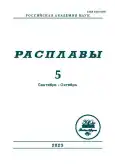CALCULATION OF THE ELECTRODE REACTION RATE ON A GRAPHITE CATHODE OF ALUMINUM-ION BATTERY WITH 1-ETHYL-3-METHYLIMIDAZOLIUM CHLORIDE
- Authors: Druzhinin K.V.1,2, Kukin A.S.2, Balakin K.Y.1
-
Affiliations:
- Institute of High-Temperature Electrochemistry, Ural Branch of the RAS
- Institute of New Materials and Technologies, Ural Federal University
- Issue: No 5 (2023)
- Pages: 502-512
- Section: Articles
- URL: https://journals.rcsi.science/0235-0106/article/view/141796
- DOI: https://doi.org/10.31857/S0235010623050043
- EDN: https://elibrary.ru/UZXFDK
- ID: 141796
Cite item
Full Text
Abstract
A method for determining the rate of sorption of chloraluminate complexes on graphite material as the main cathode reaction in aluminum-ion batteries with an ionic liquid as an electrolyte is proposed in terms of classic chemical kinetics approach. The method is applied to the description of the rate of a one-electron cathode reaction that is in the case the sorption/desorption of complexes on the electrode surface with no migration in the interlayer space of graphite taken into account. The experimental part is based on the selection and providing of measurement conditions and the ratio of the components of the cell to ensure that the rate of the cathode process sets the rate of current generation of the cell. The rate of supply/removal of electrons, as participants in the reaction, thus can be directly related to the reaction rate on graphite. The point of reaching the limiting current on the polarization curve in that case corresponds the limiting rate of the chemical sorption reaction. The approach takes into account the effect of other limiting processes, such as the rate of removal/supply of electrons, the rate of removal/supply of ions to/from the electrolyte volume, and the rate of anodic dissolution/deposition of aluminum. The calculated value of the reaction rate for graphite material grade EC-02 and low-temperature ionic liquid 1-ethyl-3-methylimidazole chloride in a mixture with aluminum chloride (1 : 1.3) was calculated to be 46 µmol/cm2 · s.
About the authors
K. V. Druzhinin
Institute of High-Temperature Electrochemistry, Ural Branch of the RAS; Institute of New Materials and Technologies, Ural Federal University
Author for correspondence.
Email: druzginin@mail.ru
Russia, Yekaterinburg; Russia, Yekaterinburg
A. S. Kukin
Institute of New Materials and Technologies, Ural Federal University
Email: druzginin@mail.ru
Russia, Yekaterinburg
K. Yu. Balakin
Institute of High-Temperature Electrochemistry, Ural Branch of the RAS
Email: druzginin@mail.ru
Russia, Yekaterinburg
References
- Muldoon J., Bucur C.B., Gregory T. Quest for nonaqueous multivalent secondary batteries: magnesium and beyond // Chem. Rev. 2014. 114. № 23. P. 11 683–11 720.
- Licht S. Marsh C. A Novel aqueous aluminum/ferricyanide battery // J. Electrochem. Soc. 1992. 139. № 12. P. L109–L111.
- Lee S., Cho J. Critical requirements for rapid charging of rechargeable Al- and Li-ion batteries // Angew. Chem., Int. Ed. 2015. 54. № 33. P. 9452–9455.
- Zafar Z.A., Imtiaz S., Razaq R., Ji S., Huang T., Zhang Z., Huang Y., Anderson J.A. Cathode materials for rechargeable aluminum batteries: current status and progress // J. Mater. Chem. A. 2017. 5. P. 5646–5660.
- Fouletier M., Armand M. Electrochemical method for characterization of graphite-aluminium chloride intercalation compounds // Carbon. 1978. 17. P. 427–429.
- Gao Y., Zhu C., Chen Z., Gang L. Understanding ultrafast rechargeable aluminum-ion battery from first-principles // J. Phys. Chem. C. 2017. 121. P. 7131–7138.
- Gifford R., Palmisano B. An aluminum/chlorine rechargeable cell employing a room temperature molten salt electrolyte // J. Electrochem. Soc. 1987. 134. P. 650–654.
- Lin M.-C., Gong M., Lu B., Wu Y., Wang D.-Y., Guan M., Angell M., Chen C., Yang J., Hwang B.-J., Dai H. An ultrafast rechargeable aluminium-ion battery // Nature. 2015. 520. № 7547. P. 324–328.
- Sun H., Wang W., Yu Z., Yuan Y., Wang S., Jiao S. A new aluminium-ion battery with high voltage, high safety and low cost // Royal Soc. Chem. 2015. 65. P. 15–18.
- Jung S.C., Kang Y.-J., Yoo D.-J., Choi J.W., Han Y.-K. et al. Flexible few-layered graphene for the ultrafast rechargeable aluminum-ion battery // J. Phys. Chem. C. 2016. 120. № 25. P. 13 384–13 389.
- Wu M., Xu B., Chen L.Q., Ouyang C. Geometry and fast diffusion of AlCl4 cluster intercalated in graphite // El. Acta. 2016. 195. P. 158–165.
- Pham H.D., Horn M., Fernando J.F.S., Patil R., Phadatare M., Golberg D., Olin H., Dubal D.P. Spent graphite from end-of-life Li-ion batteries as a potential electrode for aluminium ion battery // Sus. Mater. Tech. 2020. 26. P. e00230-1–e00230-6.
- Wu Y., Gong M., Lin M.-C., Yuan C., Angell M., Huang L., Wang D.-Y., Zhang X., Yang J., Hwang B.-J., Dai H. 3D graphitic foams derived from chloroaluminate anion intercalation for ultrafast aluminum-ion battery // Adv. Mater. 2016. 28. P. 9218–9222.
- Wang D.-Y., Wei C.-Y., Lin M.-C., Pan C.-J., Chou H.-L., Chen H.-A., Gong M., Wu Y., Yuan C. et al. Advanced rechargeable aluminium ion battery with a high-quality natural graphite cathode // Nat. Commun. 2017. 8. Р. 14283.
- Agiorgousis M.L., Sun Y.-Y., Zhang S. The role of Ionic Liquid electrolyte in an aluminum–graphite electrochemical cell // ACS Energy Lett. 2017. 2. P. 689–693.
- Jiao H., Wang C., Tu J., Tian, D., Jiao S. A rechargeable Al-ion battery: Al/molten AlCl3–urea/graphite // Chem. Commun. 2017. 53. P. 2331–2334.
Supplementary files
















